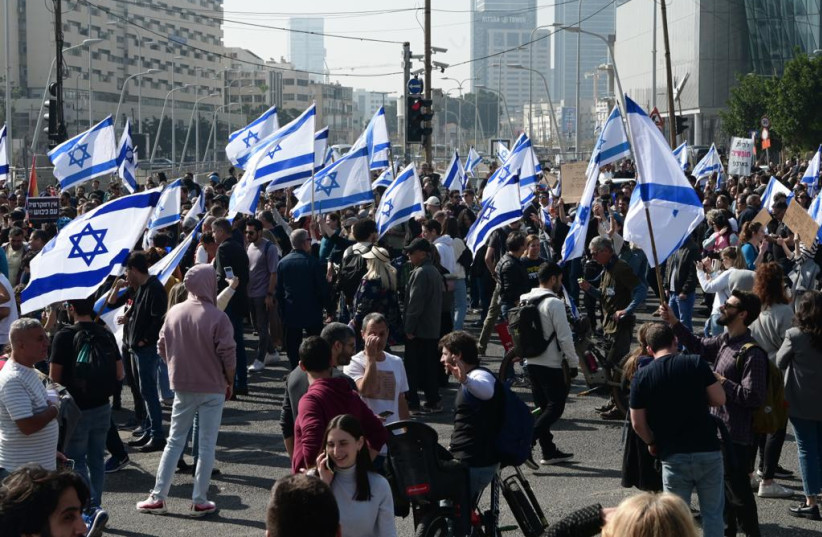Amid the chaos of protest comes orderly cacophony - comment

REPORTERS NOTEBOOK: The verdict is still out on the impact of these protests. Will they succeed in changing the government’s policy, or will the convoy move onward, despite all the noise?
There is something extremely powerful, even moving, about large demonstrations.Regardless of the cause – when you get 50,000, 60,000, 70,000 people together chanting, drumming, booing, singing, cheering and waving the national flag together – it has an effect. First and foremost on the participants.When you are in the crowd, one of tens of thousands of people fighting against the same perceived evil, or for the same perceived good, you feel an uncommon strength, that you can move mountains, or at least impact government policy.The tens of thousands of protesters who demonstrated against the Oslo Accords in the mid-1990s in the same Wohl Rose Garden where yet another massive protest against the judicial reform was held on Monday, felt that way; that they couldn’t be ignored. The tens of thousands of people who protested against the withdrawal from Gaza in 2005 felt that way, that they couldn’t be ignored.Yet they were.The verdict is still out on the impact of these protests. Will they succeed in changing the government’s policy, or will the convoy move onward, despite all the noise?
Some groups showed up to protest more than others
The decidedly Mizrachi sound of the Luzon song seemed a bit out of place, as this crowd was heavily Ashkenazi. It was also very middle-aged and included a good proportion of seniors. One striking feature of the composition of the demonstration was the scarcity of children.This stood in stark contrast to protests that accompanied the Oslo Accords and the withdrawal from Gaza, when there were always thousands and thousands of school-aged children on hand, often bussed in together with their youth groups. There was little of that at this protest.Kippa-wearers and haredim were also noticeably absent.What there were, however, were flags, tens and thousands of blue and white flags, a sea of Israeli flags flying from makeshift poles – broomsticks, bamboo sticks, metal rods. The message behind the sea of flags was simple: “Don’t say we are not patriots, we are patriots; we care about our country, this is our country.”There were also thousands of signs. And with the signs the dual nature of the protest became evident. Yes, it was against judicial reform, but it was also against this government and Prime Minister Benjamin Netanyahu, regardless of this reform. As one sign being handed out by the hundreds read, “Corrupt ones, we’re sick of you.”In other words, if the reform is significantly altered, demonstrations – though obviously much smaller – will continue.
One sign had a picture of Herzl superimposed over an Israeli flag with part of the famous verse from Ethics of the Fathers, “Know from where you came,” and under it a Turkish flag and a continuation of that verse, “and where you are going.” Another hand-made sign had an E.T.-looking figure with the words in English, “B.B, go home.”Hundreds of signs said: “Fighting for democracy.” One read, “When dictatorship is a fact, revolution becomes a right!!!,” and another had a picture of Netanyahu under the headline “The Terminator.” One woman approached the picture and hit it with a stick.
Signs there were, chants there were, there was loud booing for the Kohelet Policy Forum think tank when it was mentioned as well as jeering when the names of Likud MKs perceived to be moderate who have remained quiet in the face of the reform were called out: Yuli Edlestin, Yoav Gallant, Avi Dichter and David Bitan.
What there was not, however, were soaring speeches. Former Likud minister Dan Meridor spoke, as did former chief-of-staff Dan Halutz, and a couple of organizers of the protest movement. They repeated the same sentences and slogans that have been heard repeatedly over the last two months in demonstration after demonstration. The purpose of these speeches is not to convince, because the demonstrators are already convinced. But to energize, enthuse the crowd, make them feel the need to keep coming out.Something else absent at this protest, which is often a staple of other protests in this country, was pushing and shoving. People were downright polite to each other. The rhetoric from the speakers, the chants and the signs might have been sharp, but this was one very orderly crowd. There was no pushing and no shoving. In that sense this massive event seemed almost un-Israeli. Yet it was Israeli, very much so. At one point the MC said there was one song that unites everyone. Then the chanting stopped, the blowing of the plastic horns ceased, the banging on drums halted, and tens of thousands of people, many of them snapping to attention, sang Hatikvah.
Jerusalem Post Store
`; document.getElementById("linkPremium").innerHTML = cont; var divWithLink = document.getElementById("premium-link"); if (divWithLink !== null && divWithLink !== 'undefined') { divWithLink.style.border = "solid 1px #cb0f3e"; divWithLink.style.textAlign = "center"; divWithLink.style.marginBottom = "15px"; divWithLink.style.marginTop = "15px"; divWithLink.style.width = "100%"; divWithLink.style.backgroundColor = "#122952"; divWithLink.style.color = "#ffffff"; divWithLink.style.lineHeight = "1.5"; } } (function (v, i) { });

